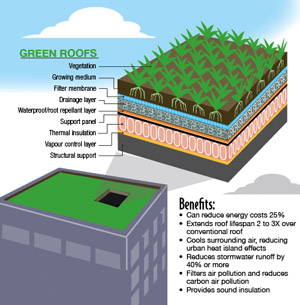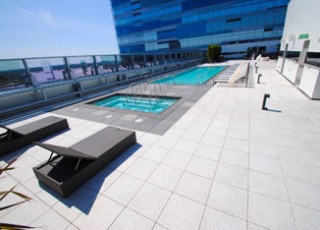Cool roof
A cool roof is one that has been designed to reflect more sunlight and absorb less heat than a standard roof. Nearly any type of building can benefit from a cool roof , but consider the climate and other factors . The roof literally stays cooler and reduces the amount of heat conducted to the building below. If a builder does not have air conditioning, this keeps the building cooler and a more constant temperature.
The most well-known type of reflective surface is the cool roof.

Reflective surfaces are a form of geoengineering. While cool roofs are mostly associated with white . California Energy Commission recogniz- es for certifying the solar reflectance and thermal emittance values of roofing products. A cool roof is a roofing system that delivers higher solar reflectance (the ability to reflect the visible, infrared and ultraviolet wavelengths of the sun, reducing heat transfer to the building) and higher thermal emittance (the ability to radiate absorbe or non-reflected solar energy) than standard designed roofing products.
Solar reflectance and thermal emittance are the two radiative properties to consider when selecting a cool roof. On a summer afternoon, the black roof at left was measured to be 30ºC (54ºF) warmer than the white roof at right. Upon completing this program, the participant should know how to: 1.

Identify what a cool roof is and what options are available for cool roofing materials. Determine what economic and environmental benefits can be realized. Define the role and mission of the CRRC. A high solar reflectance—or albedo—is the most important characteristic of a cool roof as it helps to reflect sunlight and heat away from a building, reducing roof temperatures.
A high thermal emittance also plays a role, particularly in climates that are warm and sunny. Together, these properties help roofs to . One criticism of cool roofs is that the benefits of cooling in summer can be outweighed by an increased demand for heating in winter. But according to Smith , roofs are rarely the main culprit for heat loss in Australian buildings. Sealing leaks is far more effective in preventing heat loss, according to modelling . This edition of Energy 1takes a look at how switching to a cool roof can save you money and benefit the.
The emittance of a material refers to its ability to release absorbed heat. Scientists use a number between and or and 1, to express emittance. With the exception of a metallic surface, most roofing materials can have emittance values above 0. Lower Utility Bills PGE expects a typical home will experience a reduction of to in air conditioning- related energy consumption. California Building Energy Efficiency Standards state that replacements, recovering or recoating of the exterior surface of existing nonresidential low-sloped roofs shall meet certain requirements where more than percent or more than 0square feet of roof , whichever is less, is being replace recovered or .

Cool Roofs and Emissivity. Los cool roofs son techos que tienen una alta capacidad para reflejar la radiación solar incidente y, simultáneamente, emiten energía térmica en el infrarrojo, es decir, tienen una alta reflectancia solar y una alta emisividad térmica. Los cool roof son techos que se caracterizan por una baja temperatura de superficie, incluso .